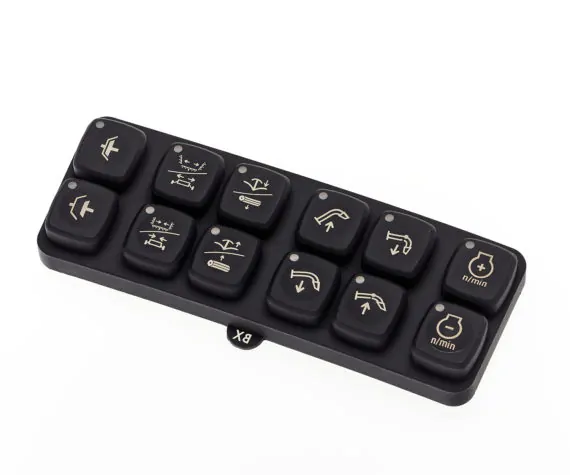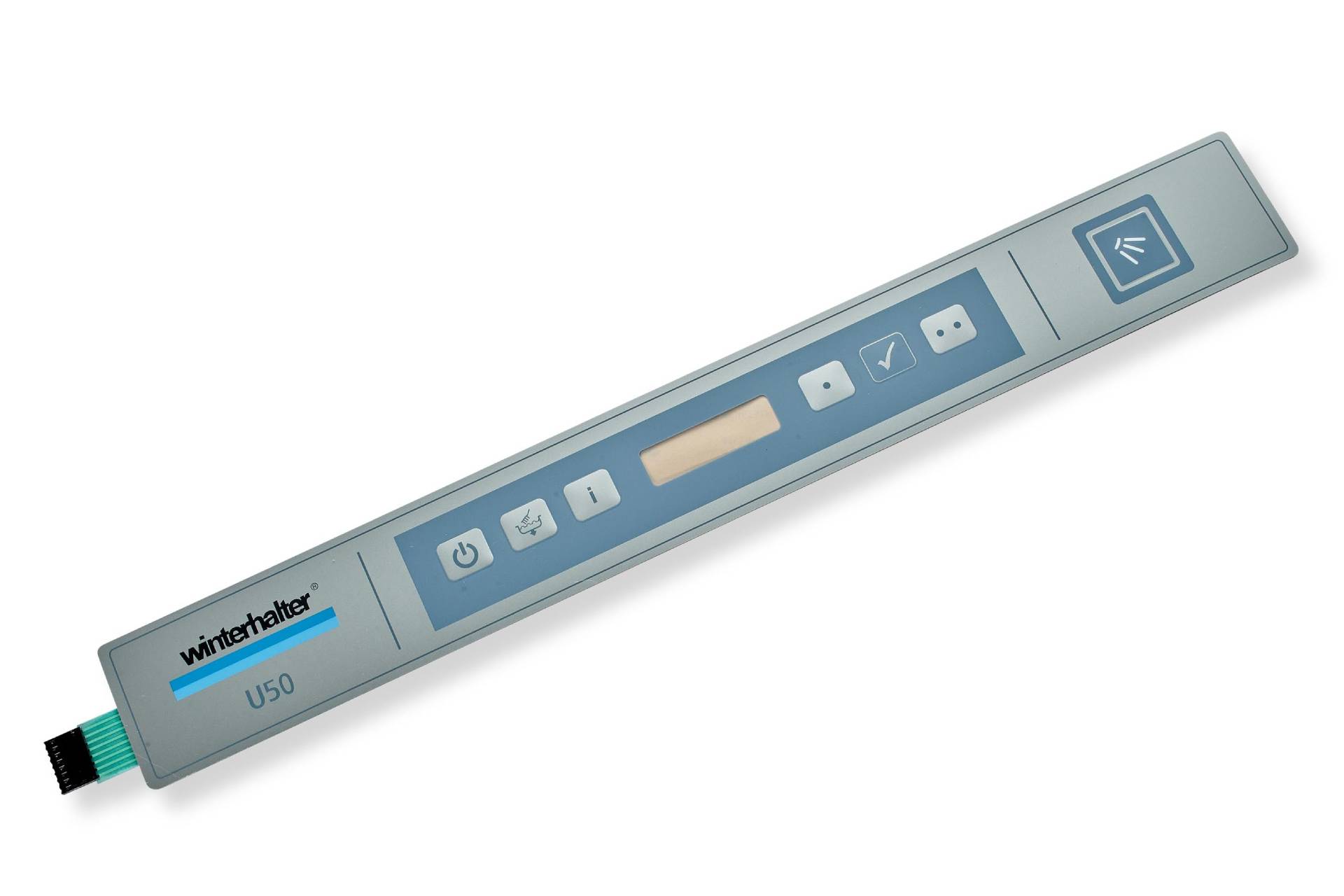The ecological footprint of producing Rubber Keypads and sustainable alternatives
A Comprehensive Overview to the Production and Processing of Rubber Keypads for Ideal Efficiency
The production and handling of rubber keypads play a necessary role in their efficiency and use. Material choice, layout accuracy, and sophisticated production techniques considerably impact their longevity and effectiveness. Recognizing these aspects is important for producing top notch items. As various innovations emerge in this field, exploring their effects could expose brand-new requirements for functionality and individual experience. What vital elements will shape the future of rubber keypads?
Comprehending Rubber Keypads: Materials and Types
Rubber keypads are important components in many devices, supplying an equilibrium of durability and tactile feedback. These keypads are mostly made from silicone or artificial rubber, products chosen for their flexibility and durability. Silicone rubber, in particular, is preferred for its superb temperature resistance and long life, making it ideal for different applications, from customer electronic devices to commercial machinery.
There are a number of sorts of rubber keypads, consisting of dome button keypads, which use a dome-shaped system that gives responsive comments when pushed. In addition, there are additionally flat keypads, which feature a smooth surface and are typically used in remotes and medical gadgets. The choice of material and type affects the keypad's efficiency, really feel, and overall individual experience. Recognizing these aspects is vital for developers and makers aiming to create reliable and trusted interfaces in their items.
The Manufacturing Refine: From Style to Production
The production process of rubber keypads involves a number of crucial phases, beginning with design and finishing with production. Originally, developers develop thorough requirements and prototypes, guaranteeing the keypad fulfills useful and visual demands. Computer-aided design (CAD) software application is frequently utilized to visualize the design and features before proceeding.
As soon as the design is finalized, material choice is crucial, with choices generally consisting of silicone or natural rubber. In the following stage, molds are produced based upon the accepted layouts, which will form the keypads throughout manufacturing.
Adhering to mold and mildew creation, the manufacturing stage commences, where rubber is blended with ingredients to boost efficiency. The blend is then poured right into molds and based on heat and stress, permitting it to strengthen and treat.
The ended up keypads go through quality checks to validate they satisfy well established requirements, complied with by product packaging for circulation. This all-inclusive procedure assurances peak performance in the end product.
Trick Techniques in Rubber Molding
In the domain of rubber keypads, numerous molding techniques play a critical duty in figuring out the quality and performance of the last product. One prevalent technique is compression molding, where raw rubber is positioned in a warmed mold and mildew and stress is applied, enabling efficient mass production and harmony. Another substantial technique is injection molding, which includes injecting warmed rubber into a mold, supplying higher precision and facility shapes. Transfer molding, a hybrid of both techniques, is also used, especially for detailed designs, as it incorporates the benefits of both processes. Additionally, liquid silicone rubber (LSR) molding is gaining traction because of its flexibility and resilience, making it perfect for high-performance applications. Each method has unique attributes, influencing aspects such as cycle time, product waste, and manufacturing expenses. Selecting the ideal molding technique is necessary for attaining peak performance in rubber keypads.
Surface Area Finishing and Texturing Options
Surface ending up and texturing choices play an important function in enhancing the tactile experience and aesthetic allure of rubber keypads. Manufacturers utilize different strategies to produce distinctive surface area characteristics that impact user communication and product style. Usual completing approaches include matte, glossy, and satin finishes, each using various visual impacts and hold degrees. Texturing options, such as raised patterns, grooves, or stippling, additionally enhance functionality by improving grip and reducing slippage during usage.
Additionally, specific structures can be tailored to satisfy ergonomic demands, providing comfort during long term usage. The choice of surface coatings and structures can be influenced by the intended application of the keypad, whether it be for consumer electronic devices, vehicle controls, or commercial devices. Ultimately, careful consideration of these alternatives adds significantly to user fulfillment and general item efficiency, making them essential elements in the style and manufacturing process of rubber keypads.
High Quality Control Measures in Rubber Keypad Production
Quality assurance procedures in rubber keypad production are vital for guaranteeing item reliability and efficiency. These procedures encompass product selection criteria, rigorous screening treatments, and rigorous last assessment requirements. Together, they develop a complete structure that helps manufacturers support high quality throughout the production procedure.

Product Choice Requirements
Choosing the appropriate materials for discover this info here rubber keypads is crucial, as it straight impacts their toughness, individual, and capability experience. Trick requirements for product choice consist of tensile toughness, durability, and environmental resistance. The selection of rubber compound, such as silicone or thermoplastic elastomer (TPE), plays a crucial function in accomplishing desired tactile feedback and durability. Furthermore, aspects like chemical compatibility, temperature stability, and UV resistance should be taken into consideration to guarantee optimal efficiency in various applications. Producers need to additionally evaluate the simplicity of processing and cost-effectiveness of materials, balancing quality with budget restrictions. Eventually, the ideal material choice not only boosts the keypad's efficiency however also adds to overall item top quality and consumer fulfillment.
Examining Treatments Carried Out
After determining the proper products for rubber keypads, strenuous screening procedures are carried out to validate that the final products satisfy market standards and customer expectations. These treatments usually consist of mechanical screening, which reviews the resilience and elasticity of the rubber under various problems. Furthermore, ecological screening evaluates the keypads' performance under temperature fluctuations, humidity, and direct exposure to chemicals. Electrical screening confirms the keypads work appropriately with digital elements, validating responsiveness and conductivity. Furthermore, responsive comments is examined to guarantee individual satisfaction. These comprehensive testing procedures are important in identifying any kind of issues or variances before mass production, eventually enhancing the integrity and performance of rubber keypads in their designated applications.
Last Examination Requirements
Detailed final examination standards are essential in rubber keypad production to assure that each unit meets the specified requirements for functionality and look. This process usually involves aesthetic analyses to recognize any type of surface defects, such as staining or imperfections. In addition, responsive examinations determine that the keypads react accurately to touch, maintaining the needed level of level of sensitivity. Sturdiness examinations might additionally be carried out, imitating extended usage to validate the long life of the keypad under numerous problems. Adherence to industry laws and client specs is confirmed to maintain quality assurance. By carrying out these rigorous evaluation measures, suppliers can significantly minimize the danger of defects, making certain that the end product is check my reference trustworthy and satisfies customer expectations, inevitably enhancing consumer contentment.
Innovations in Rubber Keypad Modern Technology
As technology continues to advance, developments in rubber keypad modern technology are improving user interfaces across different sectors. One substantial innovation is the assimilation of capacitive touch sensors within rubber keypads, allowing for an extra receptive and functional customer experience. This innovation allows users to interact with tools via touch, boosting capability without sacrificing the responsive feedback that rubber keypads are known for.
Furthermore, enhancements in product formulas have caused the advancement of more long lasting, weather-resistant rubber, making keypads suitable for industrial and outside use. Boosted printing strategies also permit high-resolution graphics and backlighting choices, raising visibility and visual charm.

In addition, advancements in making processes, such as 3D printing, are enabling personalized designs and rapid prototyping, enhancing production timelines. These developments collectively add to extra effective and user-friendly rubber keypads, ensuring they meet the demands of contemporary applications while preserving their core benefits.
Ideal Practices for Layout and Capability
Creating efficient rubber keypads calls for cautious examination of both aesthetics and performance. Rubber Keypads. A well-designed keypad ought to stabilize ergonomic concepts with aesthetic allure to boost user experience. Trick factors consist of size, form, and spacing of buttons, guaranteeing they are simple to press while stopping unintended activation. Utilizing contrasting shades and structures can enhance presence and responsive responses, aiding individuals in distinguishing between tricks
In addition, the selection of materials plays a necessary duty; top quality rubber compounds can boost durability and resistance to wear. It is also important to think about the integration of functions such as backlighting and custom-made graphics, which can boost usability in various atmospheres.
Prototyping and user screening are very useful in the layout process, enabling for modifications based on real-world responses. By sticking to these finest techniques, suppliers can develop rubber keypads that not only look appealing but also satisfy the functional needs of customers properly.
Frequently Asked Concerns
How Do I Select the Right Rubber Product for My Keypad?
To pick the right rubber product for a keypad, one need to think about aspects such as sturdiness, ecological resistance, responsive feedback, and compatibility with the desired application, ensuring suitable efficiency and individual satisfaction in different conditions.
What Are the Environmental Impacts of Rubber Keypad Manufacturing?
Rubber keypad manufacturing can result in environmental influences such as logging for natural rubber sources, air pollution from chemical procedures, and waste generation. Lasting techniques and materials can mitigate a visit their website few of these adverse impacts on communities.
Can Rubber Keypads Be Recycled or Reused?
Rubber keypads can be reused, however the procedure depends on the particular materials made use of in their manufacturing. Recycling them in different applications is likewise feasible, contributing to lose reduction and advertising sustainability in making methods.
What Is the Typical Life-span of a Rubber Keypad?
The ordinary life expectancy of a rubber keypad generally varies from 5 to one decade, relying on use, ecological elements, and upkeep. Regular treatment can prolong its performance, while too much wear may shorten its toughness.
Exist Any Kind Of Health And Wellness Concerns Connected To Rubber Keypad Materials?
There are possible health issues related to rubber keypad materials, including allergic reactions to particular chemicals and toxic irritants used in manufacturing. Proper handling and recognition of product structure can mitigate these risks for individuals.
There are numerous types of rubber keypads, including dome switch keypads, which use a dome-shaped system that provides tactile responses when pushed. Picking the suitable products for rubber keypads is vital, as it directly influences their functionality, durability, and individual experience - Rubber Keypads. After establishing the proper materials for rubber keypads, rigorous testing procedures are implemented to verify that the final items satisfy market requirements and consumer assumptions. Rubber keypad manufacturing can lead to environmental influences such as logging for all-natural rubber resources, pollution from chemical procedures, and waste generation. Rubber keypads can be recycled, but the procedure depends on the details materials used in their production